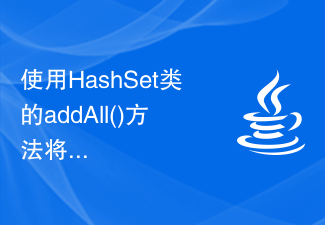
Sets and immutable sets (frozenset) in Python are two data structures used to store unique elements. They are mutable and immutable objects respectively, so they have different properties and usage. This article will introduce in detail how collections and frozenset are implemented in Python, and provide specific code examples.
1. How to implement a set:
In Python, a set is implemented using a hash table. A hash table is an efficient data structure that takes advantage of the fast lookup capabilities of hash functions. The elements in the collection are in no particular order and cannot be repeated.
The implementation of collections is based on the principle of hash tables, by storing the hash value of each element in the hash table as an index. When we add an element to the collection, Python calculates the hash value of the element and uses that value as an index to store the element at the corresponding location. When we need to determine whether an element exists in the set, Python will calculate the hash value of the element again and find the corresponding position in the hash table. If an element exists at that position, it means that the element exists in the set; otherwise, the element does not exists in the collection.
The following is a simple sample code that demonstrates the basic usage of collections:
# 创建集合
s = set()
print(s) # 输出: set()
# 添加元素
s.add(1)
s.add(2)
s.add(3)
print(s) # 输出: {1, 2, 3}
# 判断元素是否存在
print(1 in s) # 输出: True
print(4 in s) # 输出: False
# 删除元素
s.remove(2)
print(s) # 输出: {1, 3}2. The implementation of immutable collections (frozenset):
Different from collections, immutable collections The elements in are immutable, that is, the elements cannot be modified. Therefore, immutable collections are implemented differently than collections.
The implementation of immutable collections is also based on hash tables, but the hash tables are frozen when they are created, making them immutable objects. In this way, we cannot add, delete, or modify elements to the immutable collection.
The following is a simple sample code that demonstrates the basic usage of immutable collections:
# 创建不可变集合
fs = frozenset([1, 2, 3])
print(fs) # 输出: frozenset({1, 2, 3})
# 尝试添加元素(报错)
fs.add(4) # 报错: AttributeError: 'frozenset' object has no attribute 'add'
# 尝试删除元素(报错)
fs.remove(2) # 报错: AttributeError: 'frozenset' object has no attribute 'remove'
# 判断元素是否存在
print(1 in fs) # 输出: True
print(4 in fs) # 输出: FalseSummary:
Sets (set) and immutable collections (frozenset) are used in Python A data structure used to store unique elements. The implementation of collections is based on hash tables, while immutable collections are frozen into immutable objects after the hash table is created. Through the above code examples, we can better understand the usage and implementation of collections and immutable collections.
The above is the detailed content of How are sets and frozenset implemented in Python?. For more information, please follow other related articles on the PHP Chinese website!
 如何优化Java集合排序性能Jun 30, 2023 am 10:43 AM
如何优化Java集合排序性能Jun 30, 2023 am 10:43 AMJava是一种功能强大的编程语言,广泛应用于各类软件开发中。在Java开发中,经常会涉及到对集合进行排序的场景。然而,如果不对集合排序进行性能优化,可能会导致程序的执行效率下降。本文将探讨如何优化Java集合排序的性能。一、选择合适的集合类在Java中,有多种集合类可以用来进行排序,如ArrayList、LinkedList、TreeSet等。不同的集合类在
 C#中常见的并发集合和线程安全问题Oct 09, 2023 pm 10:49 PM
C#中常见的并发集合和线程安全问题Oct 09, 2023 pm 10:49 PMC#中常见的并发集合和线程安全问题在C#编程中,处理并发操作是非常常见的需求。当多个线程同时访问和修改同一数据时,就会出现线程安全问题。为了解决这个问题,C#提供了一些并发集合和线程安全的机制。本文将介绍C#中常见的并发集合以及如何处理线程安全问题,并给出具体的代码示例。并发集合1.1ConcurrentDictionaryConcurrentDictio
 使用HashSet类的addAll()方法将一个集合中的所有元素添加到另一个集合中Jul 24, 2023 am 08:58 AM
使用HashSet类的addAll()方法将一个集合中的所有元素添加到另一个集合中Jul 24, 2023 am 08:58 AM使用HashSet类的addAll()方法将一个集合中的所有元素添加到另一个集合中HashSet是Java集合框架中的一个实现类,它继承自AbstractSet,并实现了Set接口。HashSet是一个基于哈希表的无序集合,其中不允许包含重复的元素。它提供了许多常用的方法来操作集合中的元素,其中之一就是addAll()方法。addAll()方法的作用是将指定
 Java Iterator 与 Iterable:迈入编写优雅代码的行列Feb 19, 2024 pm 02:54 PM
Java Iterator 与 Iterable:迈入编写优雅代码的行列Feb 19, 2024 pm 02:54 PMIterator接口Iterator接口是一个用于遍历集合的接口。它提供了几个方法,包括hasNext()、next()和remove()。hasNext()方法返回一个布尔值,指示集合中是否还有下一个元素。next()方法返回集合中的下一个元素,并将其从集合中删除。remove()方法从集合中删除当前元素。以下代码示例演示了如何使用Iterator接口来遍历集合:Listnames=Arrays.asList("John","Mary","Bob");Iterator
 如何在Laravel中向集合添加新值?Sep 11, 2023 am 11:53 AM
如何在Laravel中向集合添加新值?Sep 11, 2023 am 11:53 AMCollectioninLaravel是一个API包装器,它帮助您处理在数组上执行的不同操作。它使用Illuminate\Support\Collection类来处理Laravel中的数组。要从给定的数组创建一个集合,您需要使用collect()辅助方法,它返回一个集合实例。之后,您可以在集合实例上使用一系列方法,如转换为小写,对集合进行排序。Example1的中文翻译为:示例1<?phpnamespaceApp\Http\Controllers;useIlluminate\Http\Re
 优化Java集合查找性能的技巧Jun 30, 2023 pm 02:57 PM
优化Java集合查找性能的技巧Jun 30, 2023 pm 02:57 PMJava开发中,使用集合是非常常见的操作之一。在实际开发中,经常需要对集合进行元素的查找操作。而集合的查找性能的高低直接影响着程序的执行效率和用户的使用体验。本文将介绍几种优化集合元素查找性能的方法。一、使用合适的集合类在Java中,有多种集合类可以选择,例如ArrayList、LinkedList、HashSet、TreeSet等等。不同的集合类有着不同的
 Java 中的数组和集合操作Jun 08, 2023 am 10:41 AM
Java 中的数组和集合操作Jun 08, 2023 am 10:41 AMJava中的数组和集合操作Java作为一门强大而受欢迎的编程语言,在编写程序时经常需要用到数组和集合。它们是Java语言中最基础、最常用的数据结构之一,用于存储、组织和操作数据。在本文中,我们将深入了解Java中的数组和集合操作。数组数组是Java语言中最基本的数据结构之一。它是一种能够存储多个相同类型数据的数据结构。数组的元素按照一定的顺序
 Java Iterator和Iterable:集合遍历的密钥,揭开其神秘面纱Feb 20, 2024 am 10:27 AM
Java Iterator和Iterable:集合遍历的密钥,揭开其神秘面纱Feb 20, 2024 am 10:27 AMIterator简介Iterator是Java中用于遍历集合的接口。它提供了一组方法,允许您以一种顺序的方式访问集合中的元素。您可以使用Iterator来遍历List、Set和Map等集合类型。演示代码:Listlist=newArrayList();list.add("one");list.add("two");list.add("three");Iteratoriterator=list.iterator();while(iter


Hot AI Tools

Undresser.AI Undress
AI-powered app for creating realistic nude photos

AI Clothes Remover
Online AI tool for removing clothes from photos.

Undress AI Tool
Undress images for free

Clothoff.io
AI clothes remover

AI Hentai Generator
Generate AI Hentai for free.

Hot Article

Hot Tools

ZendStudio 13.5.1 Mac
Powerful PHP integrated development environment

SAP NetWeaver Server Adapter for Eclipse
Integrate Eclipse with SAP NetWeaver application server.

EditPlus Chinese cracked version
Small size, syntax highlighting, does not support code prompt function

DVWA
Damn Vulnerable Web App (DVWA) is a PHP/MySQL web application that is very vulnerable. Its main goals are to be an aid for security professionals to test their skills and tools in a legal environment, to help web developers better understand the process of securing web applications, and to help teachers/students teach/learn in a classroom environment Web application security. The goal of DVWA is to practice some of the most common web vulnerabilities through a simple and straightforward interface, with varying degrees of difficulty. Please note that this software

Atom editor mac version download
The most popular open source editor






